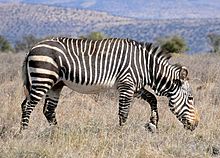Cape Mountain Zebra
| Cape mountain zebra | |
|---|---|
 |
|
| Scientific classification | |
| Kingdom: | Animalia |
| Phylum: | Chordata |
| Class: | Mammalia |
| Order: | Perissodactyla |
| Family: | Equidae |
| Genus: | Equus |
| Subgenus: | Hippotigris |
| Species: | Equus zebra |
| Subspecies: | Equus zebra zebra |
| Trinomial name | |
|
Equus zebra zebra |
|
 |
|
| Range map of Equus zebra zebra and Equus zebra hartmannae | |
The Cape mountain zebra (Equus zebra zebra) is a subspecies of mountain zebra that occurs in certain mountainous regions of the Western and Eastern Cape provinces of South Africa. It is the smallest of all existing zebra species and also the most geographically restricted. Although once nearly driven to extinction, the population has now been increased by several conservation methods, and is classified as Vulnerable by the IUCN.
The Cape mountain zebra is one of two geographically separated subspecies of the species Equus zebra (mountain zebra), the other being Hartmann's mountain zebra (Equus zebra hartmannae). The Cape mountain zebra was once was regarded as a separate species from Hartmann's mountain zebra based on taxonomic evidence but recent genomic evidence has led to the two populations now being reclassified as subspecies of Equus zebra.
Like all zebra species, the Cape mountain zebra has a characteristic black and white striping pattern on its pelage, unique to individuals. As with other mountain zebras, it is medium-sized, thinner with narrower hooves than the common plains zebra, and has a white belly like the Grévy's zebra.
The Cape mountain zebra differs slightly from the Hartmann's subspecies, being stockier and having longer ears and a larger dewlap. Adults have a shoulder height of 116 to 128 cm, making them the most lightly built subspecies of zebra. There is slight sexual dimorphism with mares having a mass of around 234 kg and stallions weighing around 250–260 kg.
Stripes of the Cape subspecies are narrower and therefore more numerous than the other two zebra species, although slightly wider than those of the Hartmann's subspecies. Stripes on the head are narrowest, followed by those on the body. Much broader, horizontal stripes are found in the hind area of Cape mountain zebra, lacking the “shadow stripes” seen in the plains zebra. Stripes on the hind legs are broader than those of the front legs, and striping continues all the way down to the hooves. However, the dark vertical stripes stop abruptly at the flanks, leaving the belly white.
...
Wikipedia

